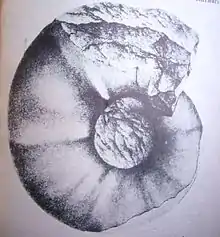Abrytasites
Abrytasites (Abrytusites) is an extinct genus of cephalopods belonging to the Ammonoidea subclass.[1] The genus was named after the ancient Roman town of Abrittus, located near the present Bulgarian city of Razgrad. There are several described species of Abrytasites, including A. thieuloyi, A. julianyi, and A. neumayri.[2][3] They are inflated, with constrictions, have rather thick ribs springing irregularly, singly or in pairs, from umbilical bullae. Their inner whorls closely resemble types species of Valdedorsella.[4] This animal lived 125-136.4 million years ago during the Hauterivian and the Barremian in Europe and western Africa.
| Abrytasites | |
|---|---|
 | |
| Abrytasites neumayri Haug, 1889 | |
| Scientific classification | |
| Kingdom: | |
| Phylum: | |
| Class: | |
| Subclass: | |
| Order: | |
| Suborder: | |
| Superfamily: | |
| Family: | |
| Subfamily: | Puzosiinae |
| Genus: | Abrytasites Nikolov & Breskovski, 1969 |
See also
References
- Nikolov, T. et Breskovski, St.(1969); "Abrytusites - nouveau genre d'ammonite barrémiennes" Bull of the Geological Institute, Ser. Paleontology, Bulgarian Academy of Sciences XVIII (Feb.): 91-6.
- Haug, E. (1889); "Beitrag zur Kenntnis der Oberneocomen Ammonitenfauna der Puezalpe bei Corvara (Süd Tirol)" Beiträge zur Paläontologie Osterreich-Ungarns und des Orients VII, 3.
- Vašíček, Zdeněk (2002); "Lower Cretaceous Ammonoidea in the Podbranč quarry (Pieniny Klippen Belt, Slovakia)" Bulletin of the Czech Geological Survey, Vol. 77, No. 3, 187–200.
- Wright, C. W. with Callomon, J.H. and Howarth, M.K. (1996), Mollusca 4 Revised , Cretaceous Ammonoidea, vol. 4, in Treatise on Invertebrate Paleontology, Part L (Roger L. Kaesler et el. eds.), Boulder, Colorado: The Geological Society of America & Lawrence, Kansas: University of Kansas Press, at 72.
External links
- Abrytasites at the Paleobiology database, 6 April 2012.
- Abrytusites at ZipcodeZoo, 19 April 2012
- Abrytusites at Sepkoski's Online Genus Database, 21 April 2012.
| Wikispecies has information related to Abrytasites. |
This article is issued from Wikipedia. The text is licensed under Creative Commons - Attribution - Sharealike. Additional terms may apply for the media files.
